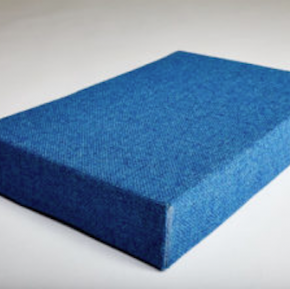
A Hush Acoustics article: Acoustics in schools, an all-inclusive problem for pupils
Over the last 50 years there has been substantial research to show that noise and poor acoustic design in schools have a detrimental effect upon pupils’ academic performance and teachers’ vocal health. A large part of children’s learning comes by hearing and absorbing what the teacher says and through conversation within the classroom. The poorer the listening environment, the less pupils are likely to learn and retain information.
Large numbers of children at risk
Poor classroom acoustics can create a negative learning environment for children. Attention must also be drawn to those with Special Educational Needs, Hearing Impairments and to those where English is an Additional Language. This counts for a huge number of children at risk of sub-standard education:
– 71% of children on the Autism spectrum attend mainstream school.
– A 2008 survey, carried out by the National Deaf Children’s Society on ‘barriers to learning’, said over a third (34%) of parents with hearing-impaired children had concerns about the acoustics in their child’s school building.
– In London alone, it is estimated that over 50% of children attending school have English as an additional language.
Collectively, we need to ensure that when we are designing schools, considerations are made for all children’s needs. A number of modifications may need to made to ensure school buildings and architecture are acoustically friendly.
This can be tricky to get right. Acoustic specification to minimise background noise, echo and reverberation will vary according to the lesson or activity at hand. The level of focus that is required, as well as the skill level and extent of the Special Educational Needs, are all varying factors.
How to solve problematic noise in the classroom
The SEN and Disability Act 2001 describes how schools must improve access to the physical environment by making specific developments and adaptations to buildings (including furniture and fittings).
The inclusion of children with special educational needs and disabilities must be forefront. In any modernisation, refurbishment or building plan, schools are required to secure access for disabled pupils. The same should be considered for sound.
Hush Acoustics work with Architects & Specifiers to ensure that when a building is designed we meet the minimum requirements of Document E, Section 5 or Part G (across the UK). When working in the Educational sector, we offer advice and design guidance in line with the BB93 (acoustics in schools guidance). We have developed products and systems to ensure compliance with all aspects of acoustic legislation.
Why choose Hush Acoustics?
We offer a unique service to the Educational sector. We visit the school buildings themselves and carry out an acoustic survey. Our design team then works with all parties to give pupils an environment to suit their requirements.
Whether we are designing partitions and wall details to prevent noise transmitting from one area to another, preventing impact and airborne noises transmitting through floors in multi-floor schools or controlling reverberation and echo within an environment to improve ambient noise levels; we will always design the solution to the requirements of the school. The pupils, and the environment, suffering from poor acoustics are our main concern.
The control of reverberation and echo noises are key to pupils’ listening and learning. Additionally, it can prevent disruption within a classroom. We have a wealth of experience and examples of the work we have carried out within schools. We work closely with head teachers, business managers, Governing Boards, Architects and Facilities Managers to help solve their problems.
When we carry out the site survey, first we work out the surface materials and volumetric requirements of the space. We use computer modelling software to calculate what the Reverberation Time (RT) is within the space, and consequently how much treatment is needed to bring the RT in line with what’s recommended for that type of environment.
We introduce our range of Hush Absorber products to tackle this issue. The Hush Absorber Range reduces the reflection of sound waves, that bounce off hard surfaces within an area. This reduces that reverberation issue. By introducing this range of products into the reverberant space, the RT is reduced. This leads to clearer speech intelligibility, which in turn increases the effectiveness of teaching and learning.
Combining years of experience with listening, innovation and expertise
Hush have the experience and ability to create better spaces for children with or without special educational needs. We seek to improve building designs & refurbishments. With our expert knowledge, we ensure a more inclusive environment. We persistently contribute to raising awareness of the benefits of good acoustics in schools.
We are committed to controlling this ever-growing issue of noisy, ineffective educational environments. If this commitment would be of interest to you, then please do not hesitate to contact us on 01519332026, or get in touch via our contact page.
Latest news

26th July 2024
Enfield Speciality Doors completes world-class project for Atlas Copco HQ
A rundown office and warehouse building completely transformed into a modern headquarters for Atlas Copco has been fitted with more than 120 internal fire doors from Enfield Speciality Doors.
Posted in Access Control & Door Entry Systems, Articles, Building Industry News, Building Products & Structures, Building Systems, Case Studies, Doors, Interior Design & Construction, Interiors, Posts, Restoration & Refurbishment, Retrofit & Renovation, Security and Fire Protection, Sustainability & Energy Efficiency, Timber Buildings and Timber Products, Wooden products
26th July 2024
Abloy UK launches new white paper
Abloy UK, a leading provider of security and access control solutions, has launched a new white paper.
Posted in Access Control & Door Entry Systems, Architectural Ironmongery, Articles, Building Industry News, Building Products & Structures, Building Services, Doors, Facility Management & Building Services, Health & Safety, Information Technology, Innovations & New Products, Publications, Research & Materials Testing, Security and Fire Protection
26th July 2024
MCRMA Member Profile: David Roy, Director of Roofconsult
David Roy of MCRMA member company Roofconsult has more than 50 years’ experience to draw upon working in the building envelope sector and a unique perspective on how it has changed in that time.
Posted in Articles, BIM, Infrastructure & CAD Software, Building Associations & Institutes, Building Industry News, Building Products & Structures, Building Services, Building Systems, Cladding, Information Technology, Restoration & Refurbishment, Retrofit & Renovation, Roofs, Walls
26th July 2024
Strand: Enhancing Door Functionality and Safety
Craig Fox, Sales Director for Strand Hardware, outlines how door industry professionals might apply door limiting stays…
Posted in Architectural Ironmongery, Articles, Building Industry News, Building Products & Structures, Building Services, Doors, Facility Management & Building Services, Health & Safety, Restoration & Refurbishment, Retrofit & Renovation
 Sign up:
Sign up: 